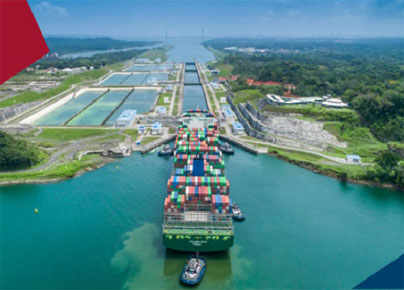Fixing problems with the Panama Canal would take years, experts say
2024-01-05

The Panama Canal Authority is studying possible solutions to the problems plaguing the canal due to the lack of rainfall. These include an artificial lake to pump water into the canal and cloud seeding to increase rainfall, but both options would take years to implement, if feasible at all.
With water levels languishing at 1.8 meters below average, the Canal Authority limited the number of ships crossing it.
The limits imposed late last year were the strictest since 1989.
Since then, the constraints have eased slightly thanks to a rainier-than-expected November, but at 24 ships a day, the maximum is still well below the pre-drought daily capacity of about 38 vessels. With the arrival of the dry season, the bottleneck is about to get worse again.
The canal's problems reflect how climate change is altering global trade flows. Last year, drought created choke points on the Mississippi River in the United States and the Rhine in Europe.
Under normal circumstances, the Panama Canal handles about 3 per cent of global maritime trade volumes and 46 per cent of containers moving from Northeast Asia to the East Coast of the United States. The canal is Panama's largest source of revenue, with $4.3 billion in 2022.
The canal will release water from Lake Alajuela, a secondary reservoir, to allow 24 ships a day to pass through during the dry season. According to the Canal Authority, if the rains start to pick up in May, the canal could begin to increase traffic.
But these are short-term solutions. In the long term, the primary solution to chronic water scarcity will be to dam the Indian River and tunnel through a mountain to carry fresh water 8 kilometres to Gatun Lake, the canal's main reservoir.
The project and other conservation measures will cost about $2 billion and take at least six years to dam and fill in the site. The U.S. Army Corps of Engineers is conducting a feasibility study.
The Indio River reservoir would increase vessel traffic by 11 to 15 a day, enough to keep Panama's primary source of revenue running at total capacity while guaranteeing fresh water to Panama City. The country will need to dam even more rivers to ensure water by the end of the century.
Moving the proposal forward will take work. It will need congressional approval, and the thousands of farmers and ranchers whose land would be flooded to build the reservoir are already organizing to oppose it.
A proposed long-term solution to alleviate chronic water shortages in the Panama Canal is to dam the Indio River.
Climate change and infrastructure expansion are the causes of the canal's problems. The Canal Authority completed a new set of locks in 2016 to increase traffic and keep pace with the growing size of cargo ships. He should have built a new reservoir to pump out enough fresh water.
Then, the drought hit. November 2023 was the driest year on record on Barro Colorado Island in Gatun Lake, according to Steve Paton of the Smithsonian Tropical Research Institute.
Global warming is intensifying the weather phenomenon known as El Niño, which has brought dry conditions to Panama and is expected to last at least until March in the Northern Hemisphere. Gatun Lake drains more.
In 2023, the trade winds never fully came in, contributing to record water temperatures on Panama's Pacific and Atlantic coasts. The weak winds also mean rain clouds reach only some way to Gatun.
The crisis has set back available shipping routes for more than a century. When it became operational in 1914, the canal offered an alternative to the Suez Canal, the Cape of Good Hope, and the Strait of Magellan for shipping goods between the northern and southern hemispheres.
Shippers are back to all three options to avoid bottlenecks in Panama, although ships have recent recently been diverted from the Suez to prevent attacks by Yemeni rebels.
Jorge Luis Quijano, a consultant and former head of the Canal Authority, says it could take a year to return to average volumes. Quijano says he saw the problem coming a decade ago when he oversaw the addition of a new set of locks to accommodate larger vessels in the canal. Locks are engineering marvels, but they're also water-guzzling.
Saltwater mixes with fresh water when the canal locks are filled. The canal discharges enough water from the lake to fill 76 Olympic-sized swimming pools with each vessel to prevent the country's largest source of drinking water, Gatun Lake, from becoming salinized.
Giant ponds inject some of this water back into the lake, but because this process increases salinity, it can only be used to a limited extent, Quijano said. Before the end of his term, he lobbied the government to start building an additional reservoir, but to no avail.









